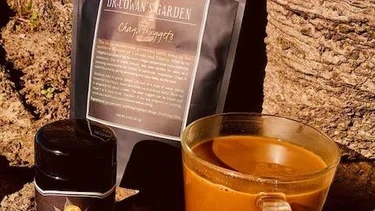Chug-a Chocolate
By Esther Boateng
Dear readers, I am excited to be joining the Dr. Cowan’s Garden family as a guest blogger and long-term fan! A little about me: I am obsessed – in a good way – about all things health-related. I have been this way for the past twelve years; my passion grows like knotweed. In this blog, I will share my take on optimal health, my wellness journey, and suggest tasty ways to incorporate Dr. Cowan’s Garden’s powders in delicious recipes. Yoga instructor, fitness fanatic, and director of household affairs are some of the ways I would describe myself. I look forward to sharing my knowledge, discoveries, and quirkiness with like-minded people. Today, I will be sharing a favorite recipe of mine, along with some history of the ingredients used.
Chug-a Chocolate
For those of you who crave cacao morning, noon, or night, this mug of medicinal mushroom with a generous heap (or two) of cacao, plus some other goodies, could become a favorite you will want to keep close at hand.
Without a doubt, fungi is in fashion. The marketplace is littered with medicinal mushrooms, some of which do not contain any mushroom, only the mycelium-cultured grain. The part of the mushroom you can pick and eat, is known as the ‘fruit’. This is the part of the mushroom you want when you buy mushroom powder from a grocery store. Or better still, use chaga in its natural form, to guarantee you are getting real mushroom. Our chaga mushrooms are sustainably harvested from the forests of northern Maine. The chaga mushroom concentrates betulin, a naturally occurring chemical found in birch tree bark, which has been shown to reduce and stabilize the formation of atherosclerotic plaque, among other beneficial effects.
Cacao is a food that needs little introduction. It is known for its list of endless benefits: potent stress buster, mood enhancer, antioxidant rich, polyphenol rich, and so on. A clinical trial published in ACS’ Journal of Proteome Research found that consuming about 40 grams - which is roughly a few squares - of dark chocolate every day for two weeks reduced the level of stress hormones in highly stressed people. It also partially corrected other stress-related biochemical imbalances.
Whenever I think of cinnamon, I imagine the smell of freshly baked Cinnabons wafting through a shopping mall. But there are healthier ways to enjoy this ancient spice. While cinnamon is generally considered to help with blood sugar regulation, it has many other health benefits. It is made from the inner bark of the Cinnamomum tree. The distinctive aroma comes from the oily part of the bark.
The two main types of cinnamon, Cassia and Ceylon, vary in quality. Cassia tends to be darker than Ceylon, which favors a lighter shade with a mild and sweet flavor. Ceylon is generally considered to be ‘true cinnamon’ and is more costly than its ‘sister.’ Whichever one you choose, you will be consuming one of the most potent spices on earth, with an ORAC value (oxygen radiant absorbance capacity) well over 100,000. (Wild blueberries have an ORAC value less than 5,000).
The first year they sleep, the second year they creep, and the third year they leap. This is a fun way to remember the perennial nature of herbaceous plants like turmeric, a wonderful orange-yellow spice, which belongs to the ginger family. Turmeric has a bitter, earthy taste. It adds a vibrant color and distinct aroma to any warm recipe. Traditionally, it was used in Ayurveda and folk medicine to treat various health conditions. Our turmeric rhizomes are carefully grown and shade dried on organic homesteads on the island of Maui, perhaps the premier turmeric-growing location in the world. As a result of the beyond-organic cultivation and gentle processing, our Turmeric Powder contains almost no bitterness and is rich in the polyphenols and curcuminoids that make turmeric such a valued spice.
Cardamom is another aromatic spice. The strong bitter taste is undeniable, and it can linger at the back of your throat. It helps eliminate mucus in the body, as well as maintain adequate levels of stomach acids. In my opinion, freshly ground spices always trump prepackaged ones.
Chyawanprash is my little dark secret. It is an extremely thick and dark substance, and looks like tar. Ever since I discovered this herbal jam, native to India, I have been using it in almost every dish that calls for a hint of sweetness. In Ayurveda, it is viewed as a nourishing, and rejuvenating medicinal food. Amalaki fruit, ghee, and honey, are some of the key ingredients in chyawanprash. It can be a bit expensive, but as I always say to my husband: ‘You can’t put a price on health.'















Leave a comment